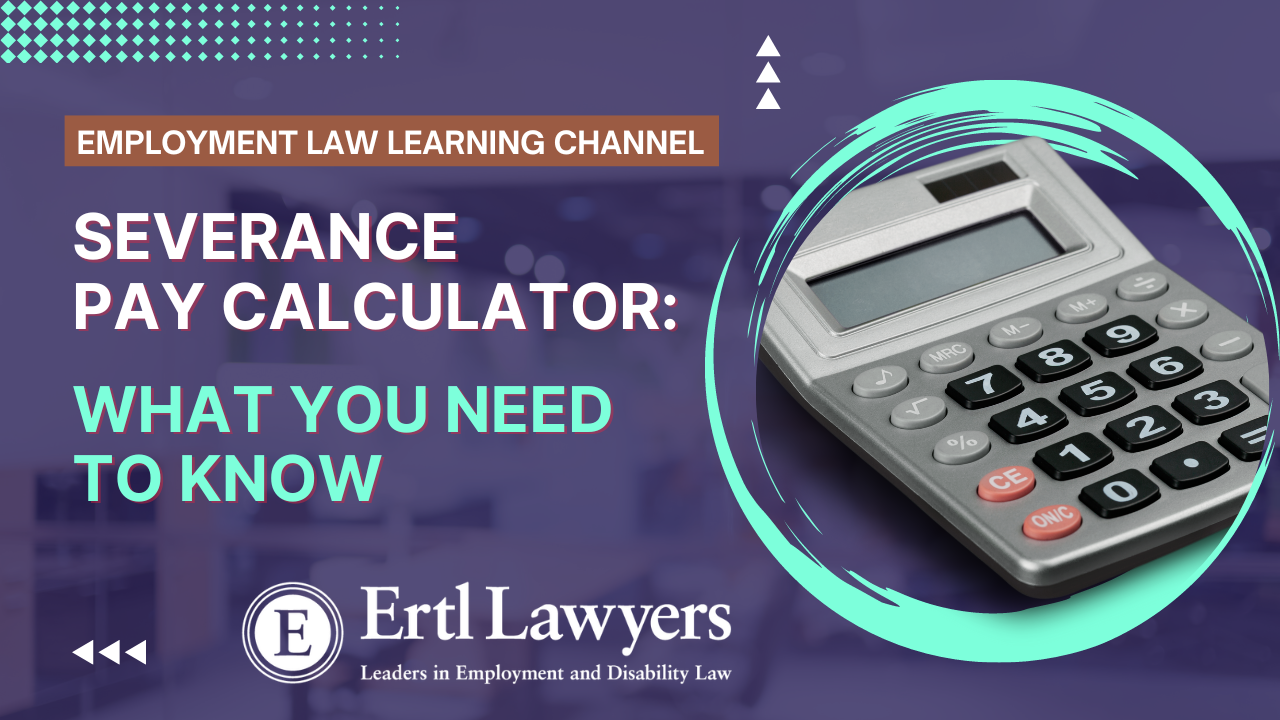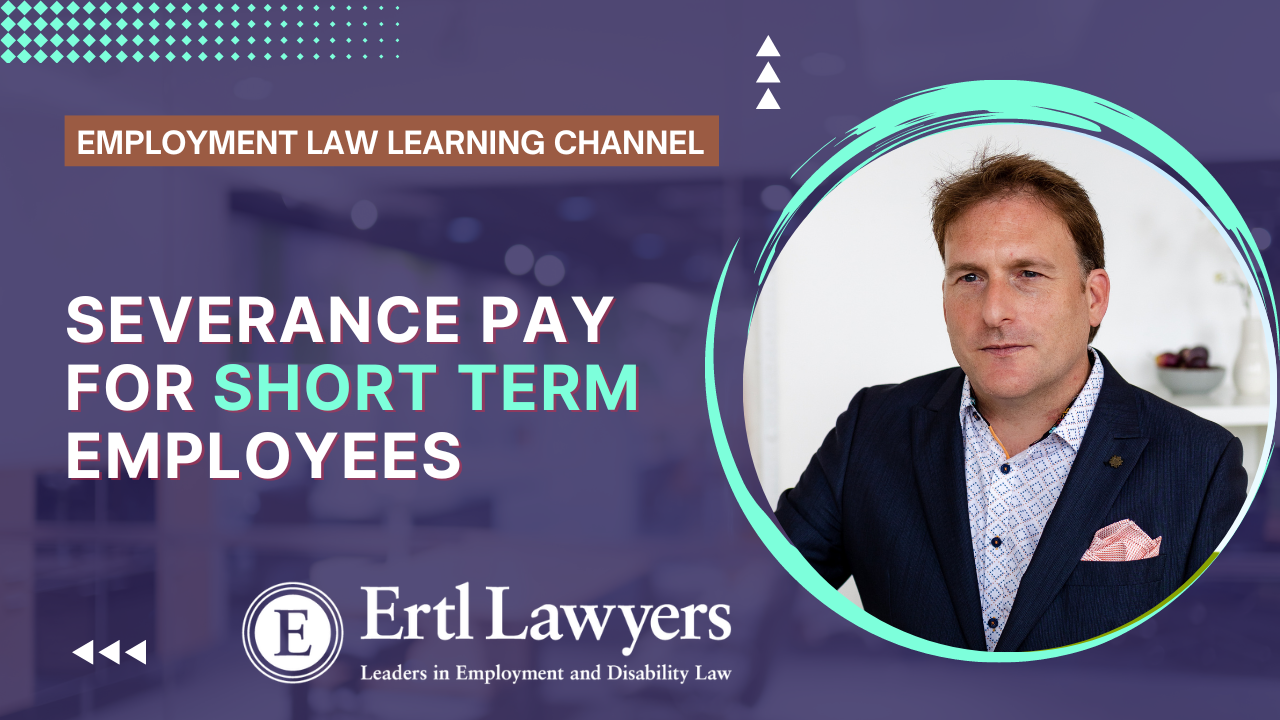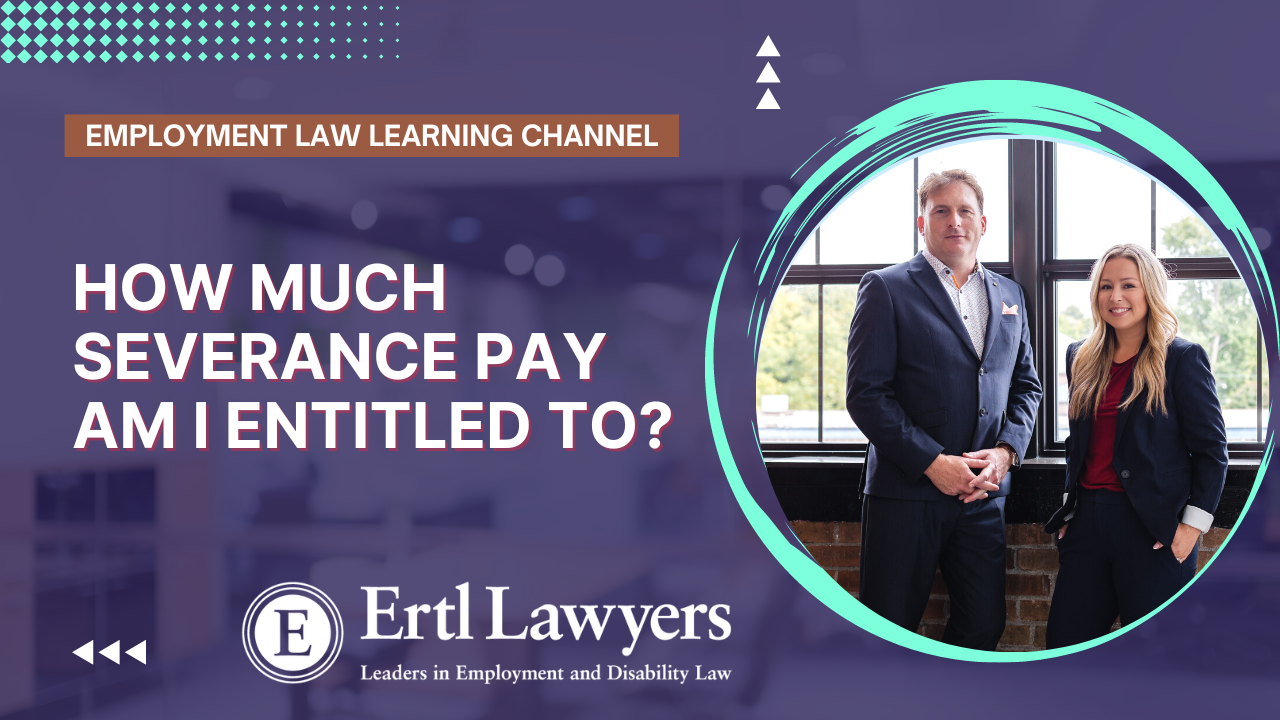Sexual Harassment in the Workplace
Sexual Harassment in the Workplace
What is the definition of workplace sexual harassment?
Where is the definition of sexual harassment found?
What are examples of sexual harassment?
Is sexual harassment in the workplace common?
What can I do about sexual harassment in the workplace?
What will happen if I report sexual harassment?
What legal options do I have?
How can Ertl Lawyers Help?
What is the definition of workplace sexual harassment?
Sexual harassment is a form of workplace harassment. Federal and provincial legislation generally define harassment as:
“engaging in a course of vexatious comment or conduct that is known or reasonably ought to be known that is unwelcome”
a) What is meant by “a course” of comment or conduct? Does the conduct have to happen more than once for it to be considered harassment?
Although the definition of harassment uses the phrase “a course” of comment or conduct, it is the law that even a single incident, if sufficiently serious, can constitute a breach of the Ontario Human Rights Code.
Examples:
- A male employee who “flicks the nipple” of a female co-worker breaches the Ontario Human Right Code [Murchie v. JB’s Mongolian Grill, 2006 HRTO 33 (CanLii)]
- A co-worker’s dropping of his pants in the presence of the complainant constitutes sexual harassment [Purdy v. Marwick Manufacturing Co. (1988), 9 C.H.R.R. D/480].
b) What does “vexatious” mean?
Vexations conduct or comment refers to actions or words that:
• provoke
• irritate
• threaten
• annoy
• insult
• demean or result in some other form of discomfort
c) What does against a co-worker “in the workplace” mean?
The workplace has been defined in court and tribunal cases as:
• work areas
• offices
• meeting rooms
• parking lots
• conferences
• holiday parties
• lunches / dinners
• sporting events
• company functions
• social media
d) What does “unwelcome” mean?
In determining whether harassment has occurred, part of the test is whether the person who engage in the conduct or comment “knew” or “should have known” that the comments or conduct were unwelcome.
In the first part of the analysis (whether a person “knew” their actions were unwelcome), knowledge can be either “actual” or “constructive”. For example, let’s say that a manager was engaging in certain conduct toward a junior employee (such as a sexual advance). If that junior employee expressly told the manager she was not interested, then the manager would have “actual” knowledge that his actions were not welcome. However, if the junior employee did not expressly voice her displeasure, but instead communicated her disinterest through body language or other conduct it could be said that the manager’s knowledge was “constructive”.
It is not necessary, however, that the person “knew” the conduct was unwelcome. It is sufficient that the person “should have known”. The standard for judging whether someone “should have known” is whether a reasonable person should have known. In short, the test is met if:
• The recipient specifically says the conduct is unwelcome;
• The recipient makes it clear through conduct or body language that the behaviour is unwelcome; or
• A reasonable person would have recognized that their behaviour would be unwelcome to that specific recipient under the circumstances.
Where is the definition of sexual harassment found?
Canadian Human Rights Act (federal legislation):
The Canadian Human Rights Act, which applies to federally regulated employers, contains the following definition:
Harassment
14 (1) It is a discriminatory practice,
(a) in the provision of goods, services, facilities or accommodation customarily available to the general public,
(b) in the provision of commercial premises or residential accommodation, or
(c) in matters related to employment,
to harass an individual on a prohibited ground of discrimination.
Sexual harassment
(2) Without limiting the generality of subsection (1), sexual harassment shall, for the purposes of that subsection, be deemed to be harassment on a prohibited ground of discrimination.
Ontario Human Rights Code:
Ontario’s Human Rights Code provides employees with the right to be free from harassment in the workplace. It contains the following provisions:
Definitions
s.10 “harassment” means engaging in a course of vexatious comment or conduct that is known or ought reasonably to be known to be unwelcome.
Harassment in employment
s.5(2) Every person who is an employee has a right to freedom from harassment in the workplace by the employer or agent of the employer or by another employee because of race, ancestry, place of origin, colour, ethnic origin, citizenship, creed, sexual orientation, gender identity, gender expression, age, record of offences, marital status, family status or disability.
Harassment because of sex in workplaces
s.7(2) Every person who is an employee has a right to freedom from harassment in the workplace because of sex, sexual orientation, gender identity or gender expression by their employer or agent of the employer or by another employee. R.S.O. 1990, c. H.19, s. 7 (2); 2012, c. 7, s. 6 (2).
Sexual solicitation by a person in position to confer benefit, etc.
s.7(3) Every person has a right to be free from,
(a) a sexual solicitation or advance made by a person in a position to confer, grant or deny a benefit or advancement to the person where the person making the solicitation or advance knows or ought reasonably to know that it is unwelcome; or
(b) a reprisal or a threat of reprisal for the rejection of a sexual solicitation or advance where the reprisal is made or threatened by a person in a position to confer, grant or deny a benefit or advancement to the person. R.S.O. 1990, c. H.19, s. 7 (3).
Reprisals
s.8 Every person has a right to claim and enforce their rights under this Act, to institute and participate in proceedings under this Act and to refuse to infringe a right of another person under this Act, without reprisal or threat of reprisal for so doing
The Canada Labour Code (governs federal employees):
The Canada Labour Code (R.S.C., 1985, c. L-2) establishes employees’ rights to employment free of sexual harassment, and requires employers to take positive action to prevent sexual harassment in the workplace. It defines sexual harassment as “any conduct, comment, gesture or contact of a sexual nature (a) that is likely to cause offence or humiliation to any employee; or (b) that might, on reasonable grounds, be perceived by that employee as placing a condition of a sexual nature on employment or on any opportunity for training or promotion.”
The Occupational Health and Safety Act (OSHA):
Workplace sexual harassment under the Occupational Health and Safety Act means:
a) engaging in a course of vexatious comment or conduct against a worker in a workplace because of sex, sexual orientation, gender identity or gender expression, where the course of comment or conduct is known or ought reasonably to be known to be unwelcome, or
b) making a sexual solicitation or advance where the person making the solicitation or advance is in a position to confer, grant or deny a benefit or advancement to the worker and the person knows or ought reasonably to know that the solicitation or advance is unwelcome.
The Workplace Safety and Insurance Board (WSIB):
Employees who experience chronic mental stress because of harassment may be entitled to benefits.
WSIB says the following about harassment, generally:
Workplace harassment occurs when a person or persons, while in the course of employment, engage in a course of vexatious comment or conduct against a worker, including bullying, that is known or ought reasonably to be known to be unwelcome.
What have the courts said about sexual harassment in the workplace?
In Janzen v. Platy Enterprises Ltd., 1989 Canlii 97, the Supreme Court of Canada discussed sexual harassment at length, and addressed the scope of what may constitute sexual harassment:
…sexual harassment in the workplace may be broadly defined as unwelcome conduct of a sexual nature that detrimentally affects the work environment or leads to adverse job-related consequences for the victims of harassment. It is, as Adjudicator Shime observed in Bell v. Ladas, supra, and as has been widely accepted by other adjudicators and academic commentators, an abuse of power. Sexual harassment is a demeaning practice, one that constitutes a profound affront to the dignity of employees forced to endure it. By requiring an employee to contend with unwelcome sexual actions or explicit sexual demands, sexual harassment in the workplace attacks the dignity and self-respect of the victim both as an employee and as a human being.
What are some examples of sexual harassment?
Examples of sexual harassment include:
• physical contact of a sexual nature, such as touching or caressing
• sexual assault
• sexual advances or demands that the recipient does not welcome or want
• threats, punishment or denial of a benefit for refusing a sexual advance
• offering a benefit in exchange for a sexual favour
• leering (persistent sexual staring)
• displaying sexually offensive material such as posters, pictures, calendars, cartoons, screen savers, pornographic or erotic websites
• sending sexually explicit e-mail messages or attachments such as pictures or video files
• sexually suggestive or obscene comments or gestures
• unwelcome remarks, jokes, innuendoes, propositions or taunting about a person’s body, clothing, or sex
• comments that degrading to a woman related to sex or gender
• rumors or gossip about an employee’s dating or sex life or sexual activities
• persistent unwanted attention after a consensual relationship ends
Is sexual harassment in the workplace common?
According to a study published in Insights on Canadian Society, titled “Harassment in Canadian workplaces,” (based on 2016 data from the General Society Survey (GSS) on Canadians at Work and Home):
• Women were more likely to report sexual harassment in their workplace (4%) than men (less than 1%). Among women who reported sexual harassment, more than half were targeted by clients or customers
• Although most of the women who reported being sexually harassed in the workplace in the past year were targeted by one perpetrator (74%), just over one-quarter of them were targeted by multiple perpetrators (26%).
• Among women who were sexually harassed in the workplace in the past year, 15% were targeted by supervisors or managers. In comparison, 56% of women who reported that they had been sexually harassed in the workplace were targeted by clients or customers, and 44% were targeted by colleagues or peers. Some research suggests that clients and customers as well as colleagues and peers are more frequent perpetrators of sexual harassment in the workplace than supervisors or managers because they have more opportunities to interact with potential targets.
• Certain personal characteristics are associated with greater vulnerability to sexual harassment in the workplace among women. Specifically, young and unmarried women were more likely to report being sexually harassed in the workplace in the past year than older and married women. For example, 7% of women aged 15 to 24 reported that they had been sexually harassed in the workplace, compared with 1% of women aged 55 to 64. Furthermore, 7% of single or never-married women reported having been sexually harassed in the workplace, compared with 2% of married women. While such results suggest that perpetrators are more likely to target young and unmarried women, it may also be that age and marital status are proxies for less seniority at work and poor job quality—factors that may increase the likelihood of experiencing sexual harassment in the workplace to the extent that they imply low organizational power. In addition, it was found that lesbian and bisexual women were more likely to report being sexually harassed in the workplace in the past year than heterosexual women (11% versus 4%).
What can I do about sexual harassment in the workplace?
Employers are responsible for providing a workplace environment that is free of sexual harassment. It is your employer’s responsibility to take action when harassment occurs.
If you have experienced or observed sexual harassment, you can try to resolve the problem through the policies or resolution mechanisms your organization has in place.
You may also wish to seek support or advice from someone you trust.
What will happen if I report sexual harassment?
If an employer complies with the law, then it should take your complaint seriously.
It should investigate your complaint in a timely manner.
A complaint is very often resolved or settled before it is heard by a decision-maker such as an arbitrator or an adjudicator. Monetary compensation, apologies, workplace transfers or safety plans may all flow from a settlement agreement.
Note: Human rights legislation prohibits “payback” or reprisal where a person raises issues or complains of sexual harassment, such as hostile behaviour, excessive scrutiny, social exclusion or other negative behaviour because someone has rejected a sexual advance.
What other legal options do I have?
Human Rights Complaint
You can make a complaint under federal or provincial human rights legislation. You may be entitled to monetary damages to compensate you for injury to your dignity, feelings and self respect. If you lost your job because of the sexual harassment, you may also be entitled to lost wages.
Occupational Health and Safety Act (OHSA)
You may be able to make a complaint or report under OHSA. Making a report would not result in monetary compensation, but Ministry of Labour inspectors may check to ensure employers, supervisors and workers are complying with workplace violence and harassment requirements.
Civil Action (for sexual assault)
If you have been sexually assaulted, you could commence a legal claim against your employer and/or perpetrator. You may be entitled to damages to compensate you for the physical and emotional consequences of the assault.
Civil Action (for wrongful dismissal and human rights damages)
Sexual harassment is likely to constitute a constructive dismissal (i.e. a termination of employment) entitling the victim to sue for proper severance pay. Further, the law permits a plaintiff to add a claim for “human rights damages” to their claim for wrongful dismissal.
Criminal Complaint
Sexual harassment can reach the level of a criminal offence. It is a crime if the harassment involves attempted or actual physical assault, including sexual assault, or threats of an assault. Stalking is criminal harassment.
Have You Faced Sexual Harassment At Work?
We are normally contacted when the victim of harassment can no longer tolerate the harassment and is seeking to leave their employment, or they have been terminated (and the harassment is related to their termination in some way). It is not uncommon for someone to have been sexually harassed in the workplace, but because of the dynamics at work, they have remained quiet (out of fear or embarrassment, for example). Subsequently, they are further victimized when they are abruptly terminated without proper compensation.
In the vast majority of cases, we are able to get our clients compensation without having to file a complaint or legal claim. Where a complaint or legal claim has to be filed, our clients have the benefit of our years of experience holding wrongdoers accountable.
Call us today, we can help.
Related Blogs
11 Signs of a Sham Performance Improvement Plan
11 Signs of a Sham Performance Improvement Plan Author: David Ertl, Employment Lawyer In the vast majority of cases, Performance Improvement Plans (PIPs) are designed to get rid of employees. As an employment lawyer with over 16 years’ experience, here are my top...
4 Important Facts About Negative Performance Reviews
4 Important Facts About Negative Performance Reviews Author: David Ertl, Employment Lawyer Receiving an unwarranted negative performance review is one sign that your employer is aiming to dismiss you, or else, convince you to quit. Here are some tips regarding...
Parental Leave in Ontario – Frequently Asked Questions
Parental Leave in Ontario - Frequently Asked Questions Author: David Ertl, Employment Lawyer What is parental leave? In Ontario, parental leave is an absence from work commencing after the baby is born. Section 48 of the Employment Standards Act, 2000 explains who is...






